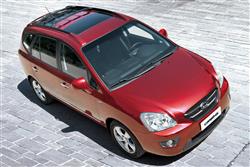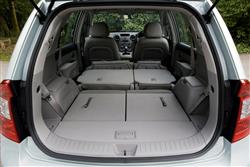CHEAP AND CHIPPER (some text hidden) --NONE--
BY STEVE WALKER
Introductionword count: 82
For families there can be a multitude of expenses that take precedence over a plush family car. Food, clothing, heating, iPods, Sony Playstations, cutting edge Nike trainers, full suspension mountain bikes and so on. Once these essentials have been provided for your brood, there are often scant funds remaining for a vehicle to transport them between their football matches, dance classes, swimming lessons and youth clubs. What is a parent to do? One refreshingly affordable option would be a used Kia Carens.
Modelsword count: 13
Models Covered: (5 dr MPV 2.0 petrol, 2.0 CRDi diesel [S, GS, LS])
Historyword count: 116
Kia first launched the Carens in 2000. It was bland but it did the compact MPV job quite well. The Carens we look at here is the second generation model that was launched in September 2006 to minimal fanfare but continues where its predecessor had left off. The Carens arrived with three trim levels and two engine options. Buyers chose between S, GS and LS trims and then deliberated over 2.0-litre petrol and 2.0-litre CRDi diesel engines. There was also the big question of whether to take your Carens in five or seven-seat guise. The entry-level S cars are five-seaters and the GS could be specified in both guises but the LS models are all seven-seaters.
What You Getword count: 490
The key decision with compact MPV models like the Carens, and the one that has taxed the minds of many major manufacturers, is whether to go with five or seven seats. Volkswagen and Ford were midway through the design process of five-seat MPVs when Vauxhall launched the seven-seat Zafira, completely changing the rules. Original designs were scrapped, only to be revisited when it was realised that a niche for five seat models still existed. Kia neatly sidestepped this quandary by offering the Carens in both five and seven seat forms. The ultimate testament to how well the Carens is packaged comes when you try to lever an adult into the back row of a seven-seat model. With most mini-MPVs, their knees will be up around their ears and there's a very good reason for this. Not only is overall legroom limited by the sheer amount of cabin space required to fit three rows of seats, but the petrol tank is usually situated under the last row, forcing the cabin floor upwards. Next time you get in a seven-seat mini-MPV, get a tape measure and check the height between the top of the seat cushion and the floor. It's often around four or five inches which is frankly laughable if you're expecting adults to get in the third row. Kia got around this problem by designing a shallow petrol tank that sits inside the rear suspension subframe. This drops the floor height by some 40mm, allowing for a more relaxed seating position. The Korean company reckoned that adults of 5'11" will be comfortable in the rearmost row of seats in the seven seat model, although that may be pushing it a little. This Carens is substantially larger than its already sizeable predecessor. Despite competing price-wise against compact MPVs, the Carens is definitely at the large end of the mini-MPV sector in terms of size. From front bumper to rear, it's less than 10cm shorter than something in the class above, such as a Volkswagen Sharan. Longer, wider and taller than its predecessor (by 55, 50 and 40 mm respectively), this Carens does not share a single panel with its predecessor and its smoother exterior results in significantly improved aerodynamics. The 4,545mm long Carens has an aerodynamic coefficient of drag of an impressive 0.32 - down from 0.35 for the previous model - which helps with fuel economy and high speed refinement. The sleek look to the Carens helps in the styling department too. The windscreen is raked further back, the front styling features a twin chromed bar grille, a lower centre air intake and a front bumper with inset air intakes or, when specified, fog lamps. There are some Sports Utility Vehicle design cues there too, with a more aggressive look and black roof rails. You'd be surprised to hear that this is one of the cheapest mini-MPVs you could lay your hands on if you didn't know what it was.
To see the full road test text contact us on 0330 0020 227
Pictures (high res disabled)
.jpg)
.jpg)
|
.jpg)
|

| |||
.jpg)
|

|
Statistics (subset of data only)
Min |
Max |
|
Insurance group: |
9 |
|
Insurance group 1-50: |
19 |
|
CO2 (g/km): |
149 |
174 |
Max Speed (mph): |
112 |
|
0-62 mph (s): |
11.6 |
|
Urban Mpg: |
31.4 |
44.8 |
Extra Urban Mpg: |
45.6 |
54.3 |
Combined Mpg: |
39.2 |
49.6 |
Length (mm): |
4545 |
|
... and 6 other stats available | ||
Scoring (subset of scores)
Category: MPV People Carriers
| Performance | |
| Handling | |
| Comfort | |
| Space | |
| Styling, Build, Value, Equipment, Depreciation, Handling, Insurance and Total scores are available with our full data feed. | |



